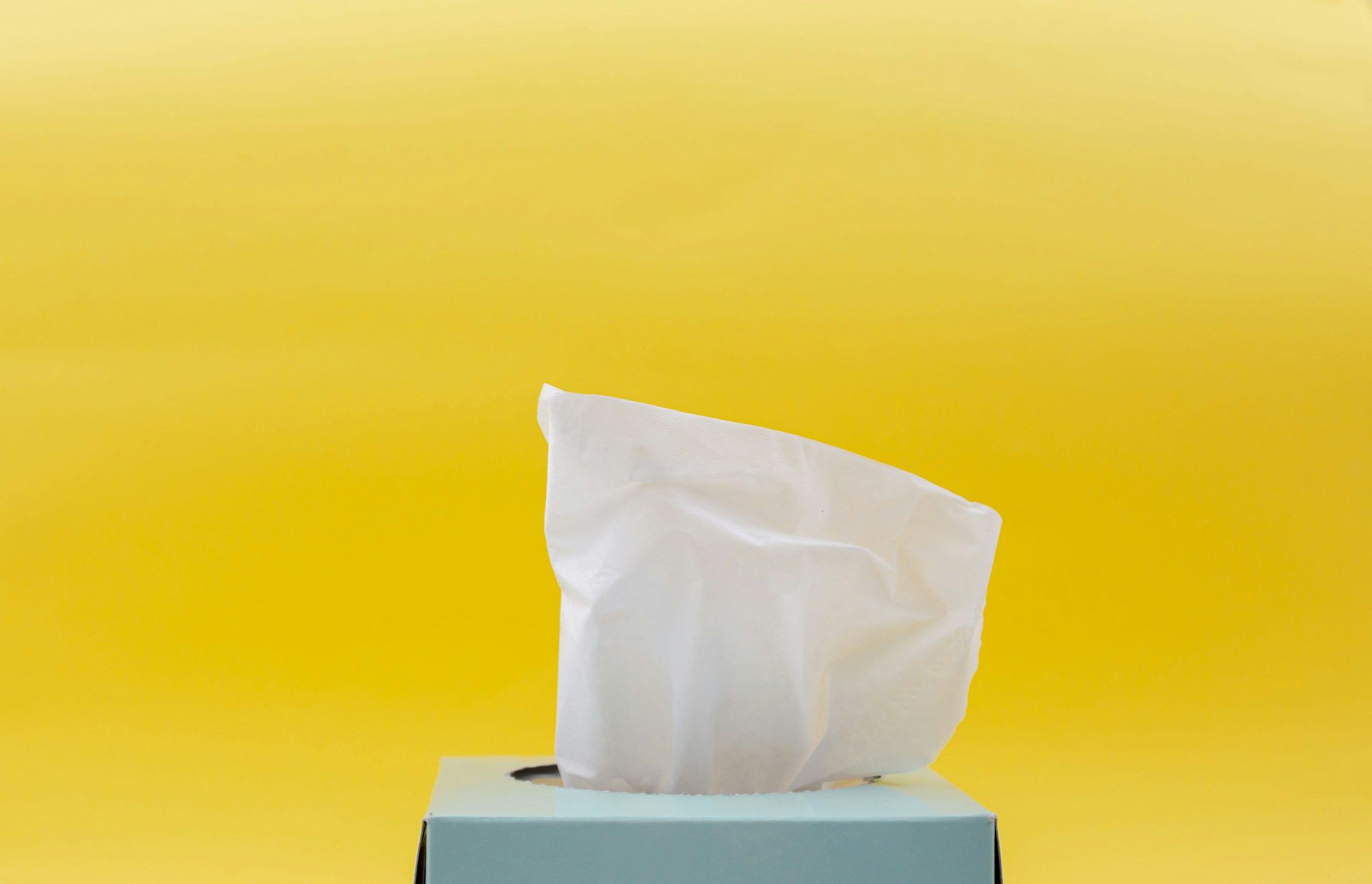Ketamine Therapy for Depression: A New Approach to Mental Health
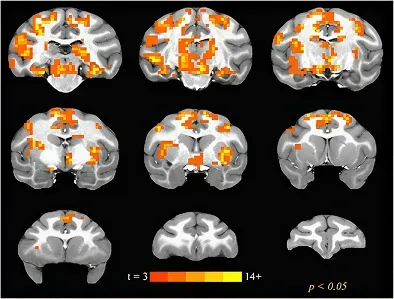
You've been fighting depression for years. The pills don't work. The therapy doesn't stick. And each failed treatment chips away at your hope that things can ever change.
How many more times can you go through the motions—trying a new prescription, waiting weeks for results, only to be let down again? It’s exhausting. And somewhere along the way, you start to wonder if anything will ever work.
Ketamine therapy is breaking this cycle for people just like you. With a 70% success rate in rapidly reducing depression symptoms, it's offering relief where traditional treatments have failed.
Continue reading to discover how ketamine therapy for depression works, why it’s different from traditional options, and what you can expect in terms of cost and care.
What is ketamine therapy?
Ketamine is a medicine that’s been around for a long time. Originally, doctors used it as an anesthetic—to safely put people to sleep during surgery. But in recent years, researchers discovered that low doses of ketamine can help treat severe or treatment-resistant depression.
Ketamine therapy for depression typically involves giving small doses of ketamine through an IV drip, a nasal spray, injection (IM), or sometimes oral pills. As opposed to antidepressants like selective serotonin reuptake inhibitors (SSRIs) medications, ketamine therapy can help reduce symptoms of depression rapidly, sometimes within hours or days.
How ketamine therapy works
Unlike traditional antidepressants that target serotonin or dopamine (happy hormones), ketamine works on glutamate—the brain’s main messenger that helps nerve cells communicate.
Ketamine blocks an NMDA receptor in the brain. By blocking this receptor, ketamine causes an increase in glutamate outside the brain cells. This activates another receptor known as the AMPA receptor, which then stimulates the release of a protein called BDNF (brain-derived neurotrophic factor).
BDNF is like a fertilizer for your brain cells. It encourages brain cells to grow, heal, and build new connections. This is important because depression damages brain cells and reduces the connections between them.
In this way, ketamine helps your brain “rewire” itself. This helps “reset” brain circuits linked to mood, memory, and learning. That’s why ketamine can sometimes pull people out of deep depression when nothing else has worked.
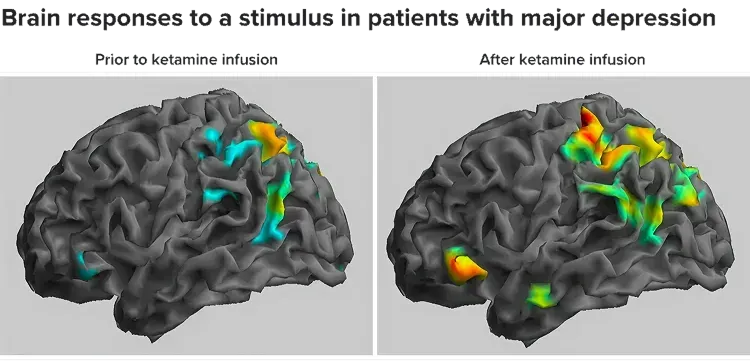
Who might benefit from ketamine therapy?
Ketamine therapy isn’t a first-line treatment, but if you’ve been through the usual options and nothing seems to help, it might be worth exploring.
You may be a good candidate if you:
-
Are living with moderate to severe depression that hasn’t improved with standard antidepressants
-
Struggle with suicidal thoughts and need quick, potentially life-saving relief
-
Have bipolar disorder, and your mood is currently well-managed with other treatments
-
Are diagnosed with post-traumatic stress disorder (PTSD) or chronic anxiety, and other therapies haven’t worked
-
Live with a personality disorder, but can safely manage treatments and actively engage in therapy
This treatment is often considered when someone has already tried things like medications, talk therapy, or even more advanced options like TMS (transcranial magnetic stimulation) or ECT (electroconvulsive therapy) — and still struggles daily.
That said, it’s not a quick fix or something you just try casually. A qualified mental health provider will look at your full history, your symptoms, and how urgently you need help before deciding if it’s the right step for you.
Looking for reliable options to access ketamine therapy abroad? QCG can help you connect with trusted, accredited clinics where safety and quality care come first.
Different ways to receive ketamine therapy
Ketamine therapy can be delivered in several ways. Let’s take a closer look at each:
1. Intravenous (IV) Ketamine Infusions
Intravenous infusion of ketamine is the most common method used in clinics. The length of one session is around 40-60 minutes.
During this duration, you are kept under constant supervision of a doctor or nurse. Once the infusion is completed, you have to stay at the clinic for about 1-2 hours, and the nurse will monitor your condition during this time.
There is a rapid decrease in depression within hours or days after the first few infusions. Your stress levels come down, and your mood improves significantly.
2. Spravato (Nasal Spray)
This is the only ketamine-based treatment approved by the FDA specifically for depression. Spravato (Esketamine) nasal spray is used for both major depressive disorder (MDD) and treatment-resistant depression (TRD). And given to you under strict medical supervision at a clinic.
Treatment sessions can last up to 2 hours, especially at the start when you typically take it twice a week before spacing out. While it’s FDA-approved and easier to use than IV infusions, its effects may not be as fast or pronounced.
3. Oral ketamine tablets
If IV or nasal spray ketamine therapy is expensive for you, a cheaper alternative is oral ketamine tablets. After consulting your doctor, you can start taking them at home. However, they require close medical monitoring, at least for the first few doses.
4. Intramuscular (IM) ketamine injections
IM injections deliver ketamine directly into your muscles. Although a less popular choice, intramuscular injections of ketamine provide quick relief from depression. Also, it is cheaper than IV infusion of ketamine.
Typically, it involves a total of 4-6 sessions. Each session lasts for about 1-2 hours. Just as IV infusion therapy, IM injections are administered at the doctor’s office under continuous monitoring.
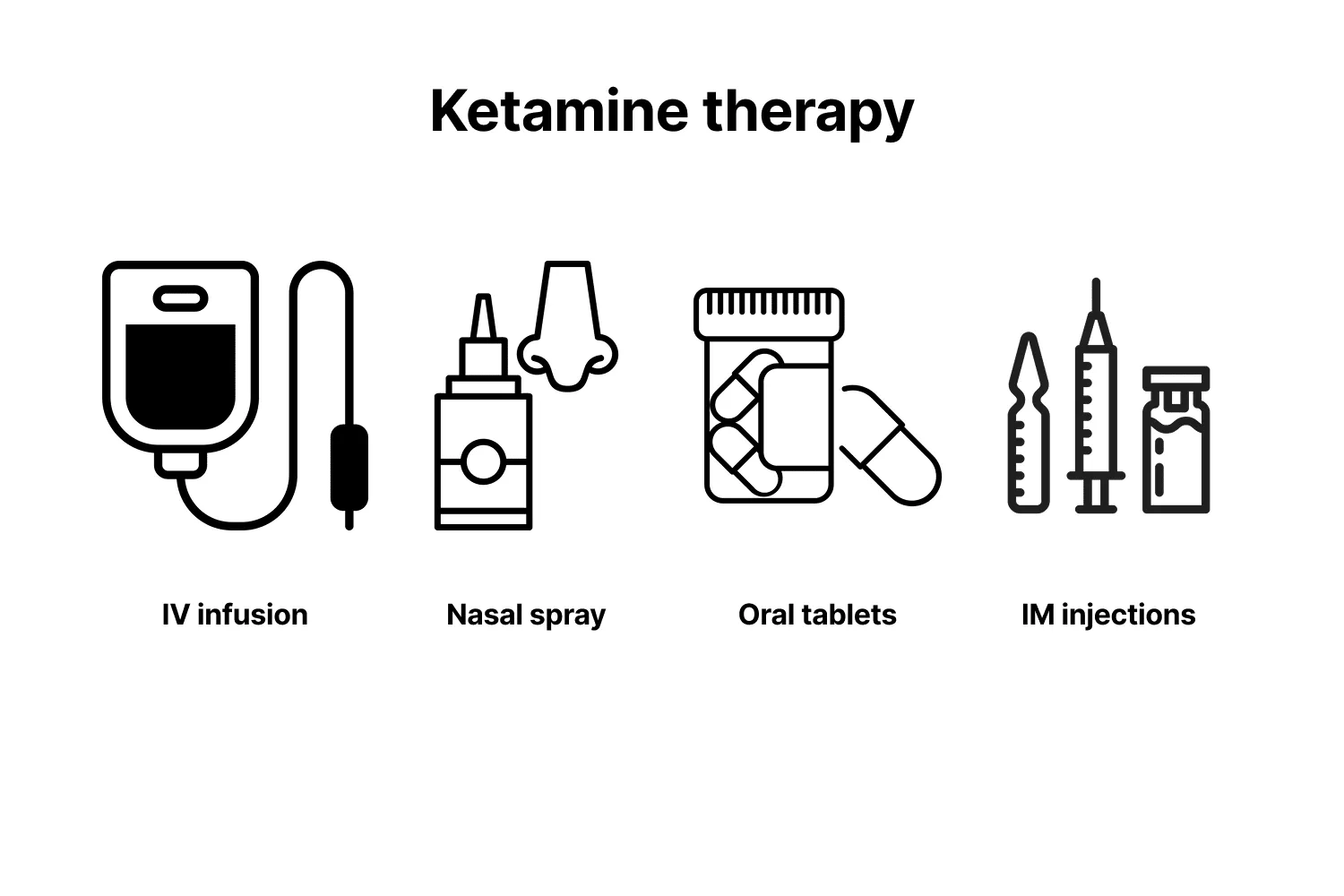
Which ketamine method works best?
So, which method is best? IV infusions are often considered the “gold standard” because they provide the fastest and most reliable results. Nasal spray is convenient and FDA-approved, but the effects can be less dramatic. Oral and IM forms are more experimental, with mixed results, but can be good alternatives depending on your situation.
Another approach gaining attention is ketamine-assisted psychotherapy, where ketamine treatment is combined with talk therapy. Early research suggests this combination may help extend the benefits for depression, anxiety, and PTSD even after the treatment ends.
Ultimately, the best method for you depends on your health, lifestyle, and what your doctor recommends.
Important Note: Except for the nasal spray, other ketamine treatments are considered off-label—widely used in clinics but not officially FDA-approved for depression
How many ketamine treatment sessions are needed for depression?
You're required to get about 6-8 sessions of IV infusions of ketamine over 2-3 weeks to have long-lasting results. Then comes the maintenance phase, in which infusions are given weekly for the first few months. You can get “booster” doses every month or as needed, according to your mental health condition.
Initial or loading phase
While it’s not the same for everyone, most people start with a short-term treatment plan known as the initial or loading phase. This usually includes six ketamine sessions, often given over a span of two to three weeks.
Each session lasts about 40 to 60 minutes. And the goal during this phase is to see how your body responds and to get symptoms under control as quickly as possible.
Some clinics might begin with as few as three sessions, or go up to eight, but six is the most widely used starting point. Most people begin to feel some relief within the first few sessions. In fact, by the time you’ve had your third infusion, it’s generally clear whether ketamine is starting to work for you.
Maintenance phase
After the initial series, your treatment may shift into a maintenance phase. This part is more flexible and personalized. Depending on how you're feeling, your doctor might recommend booster sessions every few weeks—often once every 3 to 4 weeks.
Some people may only need one booster a month, while others might go longer between sessions. Overall, it depends on how your symptoms respond over time.
However, note that one session alone usually isn’t enough. Instead, a full course gives your brain time to rebuild connections and helps create more lasting relief. Studies suggest that about 60-70% of people who complete the initial phase experience significant improvement in their depression.
Summary Table: Typical Ketamine Therapy Schedule
| Phase | Number of Sessions | Time Frame | Purpose |
|---|---|---|---|
| Initial Phase | 6 | 2–3 weeks | Rapid symptom reduction |
| Maintenance | 1–2 per month* | Ongoing | Sustain improvement, prevent relapse |
*Frequency varies by individual response.
How effective is ketamine therapy for depression?
While ketamine isn’t right for everyone, the research supports its effectiveness for many people facing difficult-to-treat depression. If you’ve tried two or more antidepressants without success, ketamine might be a treatment to consider.
Research shows that a single IV ketamine infusion can reduce symptoms within 24 hours for many people. That’s much faster than traditional antidepressants, which often take weeks or even months to have an effect.
In a large study involving over 500 patients at 178 clinics, about 54% of people responded well to ketamine therapy. Plus, nearly 30% even experienced full remission, meaning their depression symptoms completely disappeared.
Ketamine also helps a lot with suicidal thoughts, which is something many people with depression struggle with. In that same study, over 70% of people with suicidal thoughts saw those feelings improve, and about 40% no longer had them at all after treatment.
And the major plus point is that the positive effects of ketamine aren’t short-lived. For around 80% of people, the benefits lasted at least four weeks. And for about 60%, the relief lasted eight weeks or more, even without additional treatments.
Many clinics offer follow-up doses to help maintain these benefits. This makes it a helpful option for people who have struggled to find effective treatments elsewhere.
Who should avoid ketamine therapy?
While ketamine can offer powerful results, it’s not suitable — or safe — for everyone.
You may not be a good fit for ketamine therapy if you:
-
Have a history of substance abuse (like heavy alcohol, cannabis, or non-prescribed drug use)
-
Have experienced psychosis or severe hallucinations in the past
-
Are dealing with uncontrolled high blood pressure
-
Have serious or unstable heart conditions
-
Are currently pregnant or breastfeeding
-
Have a history of increased pressure in the brain (known as intracranial pressure)
-
Had a negative or harmful reaction to ketamine in the past
Your doctor may also require a drug screening before and during treatment to make sure it’s safe for you.
How much does ketamine therapy cost?
The average cost of ketamine therapy in the U.S. ranges from $300 to $1300, depending on the clinic, doctor’s expertise, and type of method used for giving the ketamine dose.
| Method | Average Cost (USD) |
|---|---|
| IV Infusion | 400-1000 (per session) |
| Spravato Nasal Spray | 900-1300 (per session) |
| IM Injection | 300-400 (per session) |
| Oral Tablets | 75-200 (per prescription) |
Ketamine therapy is an expensive treatment. It is hard to manage the cost of complete treatment and follow-up visits. Therefore, not everyone has access to ketamine treatment for depression.
Interested in learning whether ketamine therapy is available in your country or elsewhere at a lower cost? QCG offers expert guidance on affordable treatment options. Get in touch today!
Does insurance cover ketamine therapy?
Since the use of ketamine for treating clinical depression is not FDA-approved, insurance does not provide any coverage for the cost of ketamine therapy. Therefore, ketamine therapy for depression is an expensive treatment costing thousands of dollars.
The only exception is Spravato (esketamine) nasal spray treatment, which costs only $40-$60 per session with insurance.
Some ketamine therapy clinics offer financial assistance programs and installment payment plans to provide financial support to their patients.
The step-by-step IV ketamine therapy process
Here is a detailed walkthrough of the IV ketamine infusion treatment:
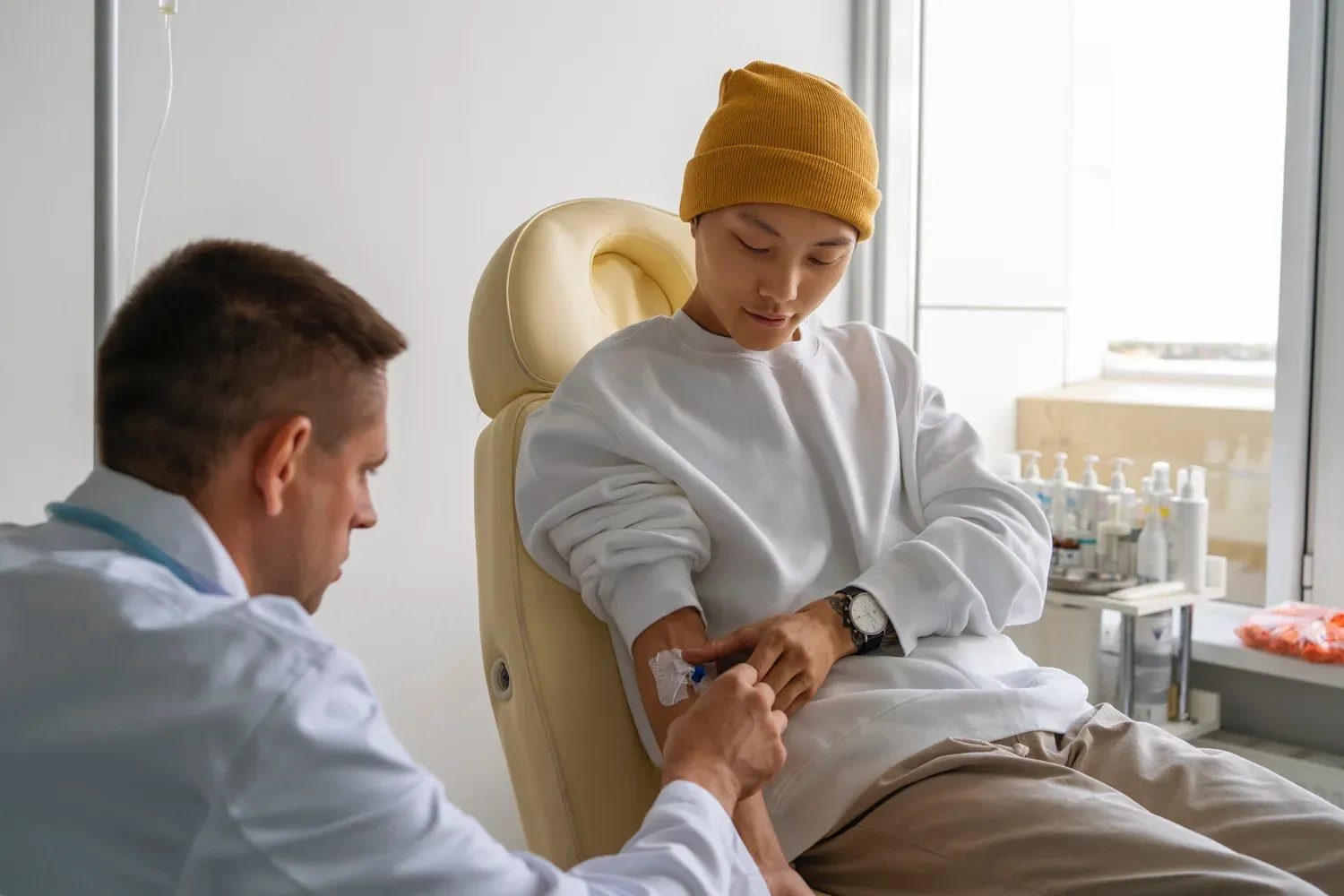
1. Before the infusion
-
Have a discussion with your doctor about the adjustments in the medications you're currently on. Also, ask any questions you might have regarding ketamine treatment.
-
Abstain from eating and drinking for some hours before infusion.
2. During the infusion
-
At the clinic, you will sit in the examination chair.
-
An IV line will be inserted into your arm.
-
The IV ketamine infusion process will last for about one hour.
-
During the whole process, your vitals will be monitored.
3. After the infusion
-
You will stay at the clinic for an additional 30-60 minutes.
-
During this time, the medical staff will monitor you for any side effects, after which you are allowed to go home.
4. Precautions after IV ketamine infusion
Due to side effects such as dizziness, you must follow these precautions:
-
Bring someone with you to the clinic on the day of your ketamine infusion.
-
Do not drive. Let someone else drop you home.
-
Do not operate any heavy machinery.
-
Avoid making any important financial or business-related decisions for a day after getting the infusion.
Ketamine therapy side effects
Ketamine is generally safe when given at the recommended dose (usually between 0.2 to 0.5 mg per kilogram of body weight) for depression. However, some side effects can occur, including:
-
Dizziness
-
Feeling disconnected or “out of body” (called dissociation)
-
High blood pressure
-
Nausea
-
Vomiting
-
Sedation
-
Blurred vision
-
Headache
-
Anxiety
-
Hallucinations
These side effects may occur during or shortly after the therapy and typically resolve on their own. However, if the effects are persistent or seem to get worse, inform your doctor immediately.
Can ketamine therapy make depression worse?
While it's natural to wonder about potential downsides, the risk of ketamine therapy making depression worse appears to be very low. According to recent research, only about 1.8% to 5.5% of people reported a worsening of their symptoms during IV ketamine treatment.
This suggests that, for the vast majority of patients, ketamine therapy is generally well-tolerated and does not lead to a decline in mood. Still, everyone responds differently, so it’s important to stay in touch with your doctor to track your progress and adjust treatment if needed.
Is ketamine therapy for depression right for you?
If you’re living with depression that hasn’t improved despite trying different treatments, ketamine therapy might be an option worth exploring. It’s not usually the first step, but for many people with treatment-resistant depression or severe symptoms, it has offered meaningful relief—sometimes within days.
That said, ketamine isn’t suitable for everyone. Your medical history, current symptoms, and treatment goals all matter in deciding if it’s the right fit. If you're considering this therapy and want access to safe, professionally supervised care, possibly even at a lower cost, Quality Care Global (QCG) can help connect you with trusted clinics through our global health network.

